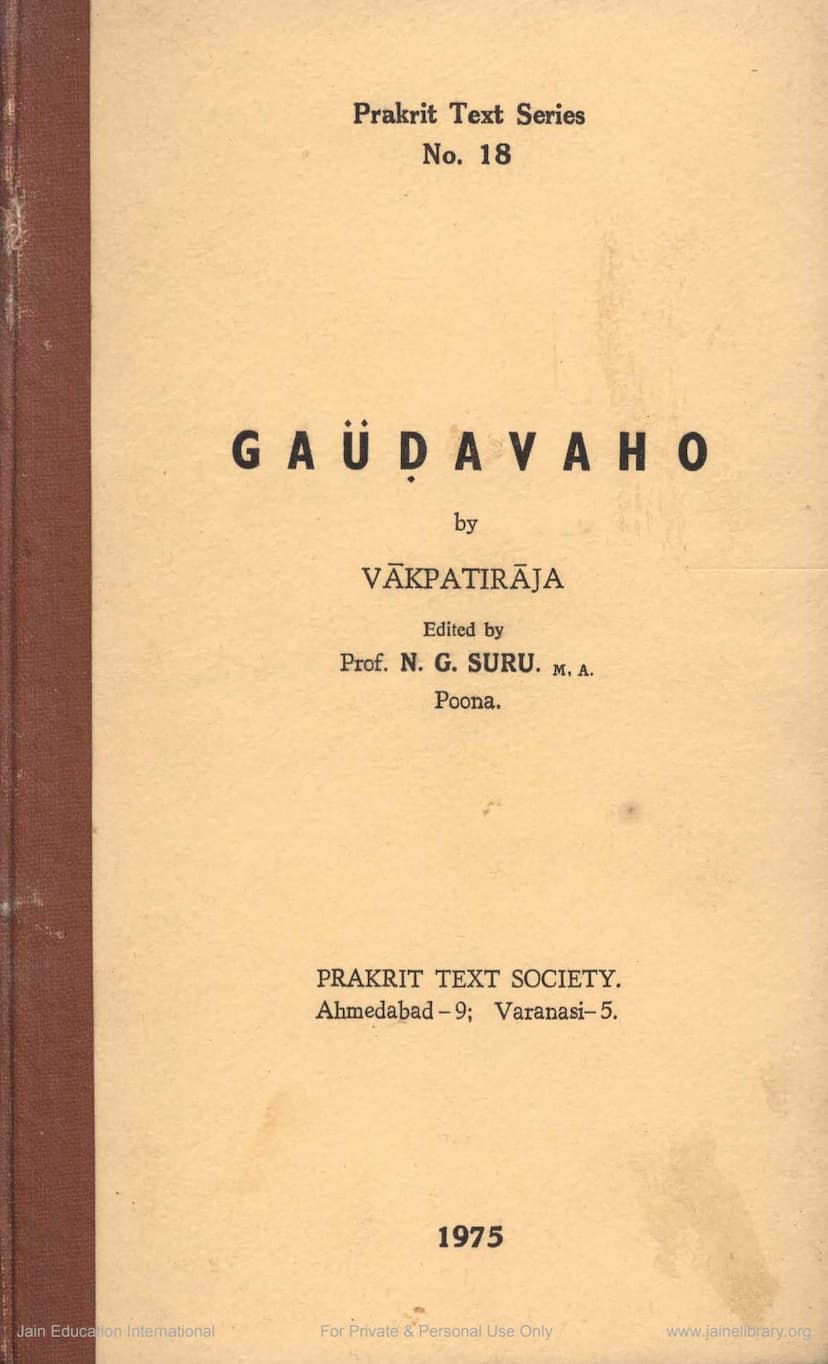Gaudavaho
Added to library: September 1, 2025

Summary
Here's a comprehensive summary of the Jain text "Gauḍavaho" by Vākpatirāja, based on the provided English text:
Gauḍavaho: A Summary
Book Title: Gauḍavaho Author: Vākpatirāja Publisher: Prakrit Text Society Ahmedabad Year: 1975 (Edited by Prof. N. G. Suru)
Overview:
The Gauḍavaho is a significant Mahākāvya (epic poem) composed in Prakrit by the poet Vākpatirāja, who flourished in the court of King Yasovarman of Kanauj in the first half of the 8th century AD. The poem celebrates the military prowess of its patron, King Yasovarman, with a particular focus on his victory over the King of Gauda. While the title suggests a detailed account of this specific event, the poem is more broadly a historical chronicle of Yasovarman's military campaigns and a rich tapestry of descriptions of nature, seasons, courtly life, and societal conditions of the era.
Key Aspects of the Poem:
-
Patronage and Author: Vākpatirāja enjoyed the patronage of King Yasovarman and was honored with the title Kavirāja. He was well-read in earlier classics and was a contemporary and associate of Bhavabhūti. His literary activities are assigned to the early 8th century AD.
-
Prakrit Language: Vākpatirāja composed the Gauḍavaho in Prakrit, a choice that, according to some scholars mentioned in the introduction, might have contributed to his poetry not being as widely appreciated as it deserved, as Sanskrit was the dominant literary language of the time. He extols the Prakrit language as the fountain of all languages, including Sanskrit.
-
Structure and Composition: Unlike traditional Sanskrit Mahākāvyas, the Gauḍavaho lacks divisions into Sargas or Cantos. It is a continuous composition, organized into Gāthās grouped into Kulakas (groups of verses). This unique form is later adopted by Kuṭūhala in his Lilāvatī. The poem contains 1209 Gāthās (with some manuscripts noting additional ones).
-
Content and Themes:
- Invocations: The poem begins with invocations to various Hindu deities, reflecting a catholic approach to worship.
- Praise of Poets: Vākpatirāja includes a section praising poets in general, discussing their craft, their struggles, and their impact on readers.
- King Yasovarman's Glory: The central narrative, though cursorily treated in relation to the title, celebrates Yasovarman's military expeditions (digvijaya) across India. This includes detailed descriptions of:
- Military Marches: The movement of his large army, its components (infantry, cavalry, chariots, elephants), and the impact on the environment.
- Conquests: The defeat of various kings, including the King of Magadha (likely the Gauda king), the King of Vangas, and the Southern King.
- Mythological Episodes: The poem incorporates mythological episodes like Indra cutting the wings of mountains, universal conflagration and dissolution (Pralaya), King Pṛthu leveling the earth, Janamejaya's Serpent Sacrifice, the heavenly flight of Ayodhya (city of Hariscandra), the churning of the ocean, and Siva's transformation into a lion.
- Descriptions of Nature: Vākpatirāja is renowned for his vivid and realistic descriptions of seasons (summer, rainy season, winter), landscapes, forests, mountains, lakes, rivers, villages, and rural life. His love for nature and keen observation are highlighted.
- Eroticism: The poem contains extensive descriptions of love scenes, dalliances, and the beauty of women, fulfilling a requirement of Mahākāvyas, though some critics find it bordering on carnality.
- Autobiographical Notes: Vākpatirāja includes personal details about himself, his literary predecessors, and his intellectual influences.
- Social Commentary: The poem offers a picture of the society of the time, touching upon religious tolerance (Hinduism, Buddhism, Jainism), social conditions (caste system, occupations), urban and rural lifestyles, clothing, adornments, and political conditions (monarchical rule, army composition, administration).
- Historical Context: The poem provides historical material related to King Yasovarman, his contemporaries like Lalitāditya Muktāpiḍa of Kashmir, and the political landscape of North India in the 8th century AD.
-
Poetic Merit: Vākpatirāja is lauded as a gifted poet, comparable to Māgha and Bhāravi. He is particularly noted for his mastery of Utprekṣā (poetic fancy or imagination), which he employs with remarkable skill, often diverging into mythological episodes. His style is precise and pregnant with meaning. He displays a realism in his descriptions that is often described as "photographic prints" of what he observed.
-
Controversy Regarding Completeness: There is scholarly debate about whether the Gauḍavaho is a complete poem or merely a prelude to a larger work. Some scholars, like S. P. Pandit and G. Bühler, suggest it's a prelude, as the main event (slaying of the Gauda king) is not detailed, and the final verse implies the narration is about to begin. Others, like H. Jacobi, argue that the current text is complete but possibly an epitome, from which historical details were omitted. The editor, N. G. Suru, acknowledges this controversy but presents the work as published.
-
Language and Style: The poem is written in a refined Prakrit, primarily Mahārāṣṭri, rich in vocabulary, including Tatsama, Tadbhava, and Desi words. Vākpatirāja mixes the Gaudi and Vaidarbhi styles, leaning more towards Gaudi. His style is considered cultivated, pregnant, and sometimes difficult due to long compounds, characteristic of the age.
-
Edition: This particular edition by N. G. Suru is highly valued for its comprehensive introduction, Sanskrit chāyā (literal translation), English translation, scholarly notes, valuable appendices (including extracts from Rājatarangini and verses attributed to Vākpatirāja), and a glossary of notable words.
Overall Significance:
The Gauḍavaho stands as a testament to Vākpatirāja's poetic genius and offers invaluable insights into the history, culture, society, and literature of 8th-century India. Despite the scholarly debates surrounding its completeness, the poem remains a rich source for understanding the literary and cultural milieu of the period and the exceptional talent of Vākpatirāja.